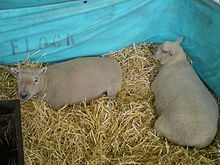 At the Great Yorkshire Show in 2011 At the Great Yorkshire Show in 2011 | |
| Conservation status | |
|---|---|
| Other names | South Down, Baby Doll, Babydoll |
| Country of origin | United Kingdom |
| Distribution | international |
| Traits | |
| Weight |
|
| Height |
|
| Wool colour | white |
| Face colour | mouse-grey |
| Horn status | polled |
| |
The Southdown is a British breed of domestic sheep, the smallest of the British breeds. It is a shortwool breed, and the basis of the whole Down group of breeds. It was originally bred by John Ellman of Glynde, near Lewes in East Sussex, in about 1800. It has been exported to many countries; it has been of particular importance in New Zealand, where it was used in the breeding of Canterbury lamb. In the twenty-first century it is kept principally as a terminal sire.
It is listed by the Rare Breeds Survival Trust among the UK native breeds; it was formerly listed as "priority" or "at risk".
History

From Mediaeval times, small grey-faced polled sheep were kept on the chalk uplands of the South Downs of the counties of Kent and Sussex in south-east England. From about 1780 John Ellman, of Glynde, near Lewes in East Sussex, began selectively breeding them to improve their productive qualities; there are no records of how this breeding was carried out. By the end of the century the breed had become well known, its reputation rivalling that of the Dishley Leicester bred by Robert Bakewell. In the nineteenth century further selective breeding was carried out by Jonas Webb, of Babraham in Cambridgeshire, with such success that the breed was at times known as the Cambridgeshire.
This sheep was involved with crossbreeding to develop other breeds:
- with the Wiltshire Horn and the Berkshire Nott, the Hampshire,
- via the Hampshire and the Cotswold sheep, the Oxford Down
- with the Norfolk Horn, the Suffolk.
Characteristics

Use
The Southdown was traditionally reared for meat and wool. During the day the sheep pastured freely on the downs, and at night they were close-folded in the arable fields of the farmers, where they helped to increase soil fertility.
Fleece weights (greasy) are about 2–3.5 kg for ewes, 3.5–5.5 kg for rams. Staple length is some 50–60 mm, and fibre diameter about 23–25 μm (equivalent to a Bradford count of 58/60s).
In California and New Zealand, they are placed in vineyards to graze weeds because they are too short to reach the grapes on the vines.
References
- Barbara Rischkowsky, Dafydd Pilling (editors) (2007). List of breeds documented in the Global Databank for Animal Genetic Resources, annex to The State of the World's Animal Genetic Resources for Food and Agriculture. Rome: Commission on Genetic Resources for Food and Agriculture, Food and Agriculture Organization of the United Nations. ISBN 9789251057629. Archived 23 June 2020.
- ^ Breed data sheet: Southdown / United Kingdom of Great Britain and Northern Ireland (Sheep). Domestic Animal Diversity Information System of the Food and Agriculture Organization of the United Nations. Accessed August 2021.
- ^ Watchlist 2021–22. Kenilworth, Warwickshire: Rare Breeds Survival Trust. Archived 12 April 2021.
- ^ Description & breed characteristics. The Southdown Sheep Society. Archived 22 September 2010.
- ^ Michael Lawson Ryder (1983). Sheep and Man. London: Gerald Duckworth & Company. ISBN 9780715616550.
- Valerie Porter, Lawrence Alderson, Stephen J.G. Hall, D. Phillip Sponenberg (2016). Mason's World Encyclopedia of Livestock Breeds and Breeding (sixth edition). Wallingford: CABI. ISBN 9781780647944.
- ^ David Cottle (2010). International Sheep and Wool Handbook. Nottigham: Nottingham University Press. ISBN 9781904761860.
- G.L Tomes, D.E. Robertson, R.J. Lightfoot (editors) (1979). Sheep Breeding. London: Butterworths. ISBN 9780408106337.
- Janet Vorwald Dohner (2001). The Encyclopedia of Historic and Endangered Livestock and Poultry Breeds. New Haven, Connecticut; London: Yale University Press. ISBN 0300088809.
- Paul Wakeham-Dawson (2002). The Remoulding and Revival of the Southdown Sheep. The Ark. 30 (Summer 2002): 68–70. Kenilworth, Warwickshire: Rare Breeds Survival Trust. Archived 23 September 2006.
- Fimrite, P. Napa sheep slaughter solved: Culprits were cougars. San Francisco Chronicle 1 April 2011. Retrieved 1 April 2011.